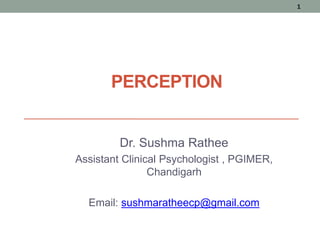
Perception
- 1. PERCEPTION Dr. Sushma Rathee Assistant Clinical Psychologist , PGIMER, Chandigarh Email: sushmaratheecp@gmail.com 1
- 2. What is Perception • Perception is the method by which the brain takes all the sensations people experience at any given moment and allows them to be interpreted in some meaningful fashion. Perception has some individuality to it.
- 3. The Constancies: 1. Size constancy: the tendency to interpret an object as always being the same actual size, regardless of its distance. 2. Shape constancy: the tendency to interpret the shape of an object as being constant, even when its shape changes on the retina. 3. Brightness constancy: the tendency to perceive the apparent brightness of an object as the same even when the light conditions change.
- 4. THE GESTALT PRINCIPLES: 1. Figure–ground: the tendency to perceive objects, or figures, as existing on a background. Reversible figures visual illusions in which the figure and ground can be reversed. • Reversible figures, in which the figure and the ground seem to switch back and forth.
- 5. • 2. Proximity: the tendency to perceive objects that are close to each other as part of the same grouping.
- 6. 3. Similarity: the tendency to perceive things that look similar to each other as being part of the same group.
- 7. 4. Closure: the tendency to complete figures that are incomplete.
- 8. 5. Continuity: the tendency to perceive things as simply as possible with a continuous pattern rather than with a complex, broken-up pattern.
- 9. • 6. Contiguity: the tendency to perceive two things that happen close together in time as being related.
- 10. 7. Common region: the tendency is to perceive objects that are in a common area or region as being in a group.
- 11. DEPTH PERCEPTION: • The ability to perceive the world in three dimensions. • Various cues exist for perceiving depth in the world. Some require the use of only one eye (monocular cues) and some are a result of the slightly different visual patterns that exist when the visual fields of both eyes are used (binocular cues). • Monocular cues are often referred to as pictorial depth cues because artists can use these cues to give the illusion of depth to paintings and drawings.
- 12. Monocular cues: 1. Linear perspective: the tendency for parallel lines to appear to converge on each other.
- 13. 2. Relative size: perception that occurs when objects that a person expects to be of a certain size appear to be small and are, therefore, assumed to be much farther away.
- 14. 3. Overlap (interposition): the assumption that an object that appears to be blocking part of another object is in front of the second object and closer to the viewer. 4. Aerial (atmospheric): perspective the haziness/cloudiness that surrounds objects that are farther away from the viewer, causing the distance to be perceived as greater.
- 15. 5. Texture gradient: the tendency for textured surfaces to appear to become smaller and finer as distance from the viewer increases. 6. Motion parallax: the perception of motion of objects in which close objects appear to move more quickly than objects that are farther away.
- 16. 7. Accommodation: as a monocular cue, the brain’s use of information about the changing thickness of the lens of the eye in response to looking at objects that are close or far away.
- 17. BINOCULAR CUES: 1. Convergence: the rotation of the two eyes in their sockets to focus on a single object, resulting in greater convergence for closer objects and lesser convergence if objects are distant.
- 18. 2. Binocular disparity: the difference in images between the two eyes, which is greater for objects that are close and smaller for distant objects.
- 19. Perceptual Selection: Internal factors include: 1. Personality – Personality traits influence how a person selects perceptions. For instance, conscientious people tend to select details and external stimuli to a greater degree. 2. Motivation – People will select perceptions according to what they need in the moment. They will favor selections that they think will help them with their current needs, and be more likely to ignore what is irrelevant to their needs. 3. Experience – The patterns of occurrences or associations one has learned in the past affect current perceptions. The person will select perceptions in a way that fits with what they found in the past.
- 20. External factors include: 1. Size – A larger size makes it more likely an object will be selected. 2. Intensity – Greater intensity, in brightness, for example, also increases perceptual selection. 3. Contrast – When a perception stands clearly out against a background, there is a greater likelihood of selection. 4. Motion – A moving perception is more likely to be selected. 5. Repetition – Repetition increases perceptual selection. 6. Novelty and familiarity – Both of these increase selection. When a perception is new, it stands out in a person’s experience. When it is familiar, it is likely to be selected because of this familiarity.
- 21. Religion and perception: • People of different religions have different perspectives on life, but do they also have different visual perceptions? It might be clichéd to say that religious people see the world differently, but new research finds that Dutch Calvinists notice embedded visual patterns quicker than their atheist compatriots. • Culture has long been known to distort visual perception, says Bernhard Hommel, a psychologist at Leiden University in the Netherlands who led the new study. • For example, one previous experiment found that Asians tend to dart their eyes around a photograph, while North Americans fix on specific people.